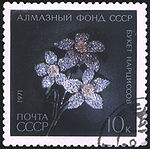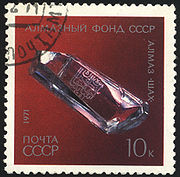
Diamond Fund
Encyclopedia

Gold nugget
A gold nugget is a naturally occurring piece of native gold. Watercourses often concentrate and grow the nuggets. Nuggets are recovered by placer mining, but they are also found in residual deposits where the gold-bearing veins or lodes are weathered...
, stored and exhibited in Moscow Kremlin
Moscow Kremlin
The Moscow Kremlin , sometimes referred to as simply The Kremlin, is a historic fortified complex at the heart of Moscow, overlooking the Moskva River , Saint Basil's Cathedral and Red Square and the Alexander Garden...
, Russia
Russia
Russia or , officially known as both Russia and the Russian Federation , is a country in northern Eurasia. It is a federal semi-presidential republic, comprising 83 federal subjects...
. The Fund dates back to the Russian Crown treasury instituted by emperor Peter I of Russia
Peter I of Russia
Peter the Great, Peter I or Pyotr Alexeyevich Romanov Dates indicated by the letters "O.S." are Old Style. All other dates in this article are New Style. ruled the Tsardom of Russia and later the Russian Empire from until his death, jointly ruling before 1696 with his half-brother, Ivan V...
in 1719.
Imperial treasury
Peter's gem collection, established in 1719, was later stored in the Diamond Chamber (Бриллиантовая комната) in the Winter PalaceWinter Palace
The Winter Palace in Saint Petersburg, Russia, was, from 1732 to 1917, the official residence of the Russian monarchs. Situated between the Palace Embankment and the Palace Square, adjacent to the site of Peter the Great's original Winter Palace, the present and fourth Winter Palace was built and...
. All succeeding monarchs added their contributions to the Chamber; a 1922 study by Alexander Fersman
Alexander Fersman
Alexander Yevgenyevich Fersman was a prominent Soviet geochemist and mineralogist, academician of the Soviet Academy of Sciences ....
identified 85% of all exhibits to 1719-1855 (from Peter I to Nicholas I
Nicholas I of Russia
Nicholas I , was the Emperor of Russia from 1825 until 1855, known as one of the most reactionary of the Russian monarchs. On the eve of his death, the Russian Empire reached its historical zenith spanning over 20 million square kilometers...
) and only 15% for the last three emperors.
Soviet Union
Preservation, sales and looting of imperial treasures after the Russian Revolution of 1917Russian Revolution of 1917
The Russian Revolution is the collective term for a series of revolutions in Russia in 1917, which destroyed the Tsarist autocracy and led to the creation of the Soviet Union. The Tsar was deposed and replaced by a provisional government in the first revolution of February 1917...
is a matter of controversy and speculation. The Imperial collection was moved from Saint Petersburg
Saint Petersburg
Saint Petersburg is a city and a federal subject of Russia located on the Neva River at the head of the Gulf of Finland on the Baltic Sea...
to Moscow
Moscow
Moscow is the capital, the most populous city, and the most populous federal subject of Russia. The city is a major political, economic, cultural, scientific, religious, financial, educational, and transportation centre of Russia and the continent...
during World War I
World War I
World War I , which was predominantly called the World War or the Great War from its occurrence until 1939, and the First World War or World War I thereafter, was a major war centred in Europe that began on 28 July 1914 and lasted until 11 November 1918...
; the Soviet Diamond Fund was officially established in 1922 (official site).
The treasure was first exhibited to the public in November 1967. Originally a short-term show, in 1968 it became a permanent exhibition.
Russian Federation
The Russian State retains the monopoly for mining and distribution of gemstones, as set by the 1998 law "On precious metals and precious stones". Diamond Fund operations are regulated by the 1999 presidential decree (official text). The Diamond Fund is part of a larger State Fund of Precious Stones, managed by the Ministry of Finance, and accumulates the most valuable items, in particular- All raw diamonds exceeding 50 carats (10 g)
- All cut diamonds exceeding 20 carats (4 g), cut diamonds of exceptional quality exceeding 6 carats (1.2 g)
- All raw emeralds, rubies, sapphires exceeding 30 carats (6 g) raw or 20 carats (4 g) cut
- Unique nuggets, amberAmberAmber is fossilized tree resin , which has been appreciated for its color and natural beauty since Neolithic times. Amber is used as an ingredient in perfumes, as a healing agent in folk medicine, and as jewelry. There are five classes of amber, defined on the basis of their chemical constituents...
, pearlPearlA pearl is a hard object produced within the soft tissue of a living shelled mollusk. Just like the shell of a mollusk, a pearl is made up of calcium carbonate in minute crystalline form, which has been deposited in concentric layers. The ideal pearl is perfectly round and smooth, but many other...
and jewellery
The public exhibits in Moscow Kremlin are only a fraction of Diamond Treasure, handpicked by the Ministry of Finance, which also manages state copyright for images of these treasures.
Recent additions
- 2006 - "The Creator" (Творец), mined in Yakutia in 2004. Third largest raw diamond in the Fund, 298.48 carats (59.696 g) www.rian.ru
- 2003 - golden nugget, 33 kg
- 1989 - "Alexander Pushkin", second-largest raw diamond, 320.65 carats (64.130 g)
- 1980 - "XXVI Congress of CPSU", largest raw diamond, 342.50 carats (68.500 g)
See also (Russian): Complete list of named Yakutian diamonds, 1959–1999, official site of Alrosa
Alrosa
ZAO ALROSA , is Russia's largest diamond company. Alrosa is engaged in the exploration, mining, manufacture and sale of diamonds. The company's operations are located primarily in the Sakha Republic/Yakutsk region. Alrosa accounts for approximately 25% of the world's rough diamond supply and 97%...
mining company www.alrosa.ru
Seven Historical Gems

- Orlov diamond (photograph) 189.62 carats (37.924 g)
- Shah diamondShah DiamondThe Diamond Shah is 88.7 carat , 3 cm long, yellow diamond, extremely clear. This diamond was found in Central India, probably in 1450....
88.7 carats (17.7 g), first inscription dated 1591, a gift of Persian Shakh in 1829 - Flat portrait diamond, 25 carats (5 g)
- Red spinelSpinelSpinel is the magnesium aluminium member of the larger spinel group of minerals. It has the formula MgAl2O4. Balas ruby is an old name for a rose-tinted variety.-Spinel group:...
, attached to the Imperial Crown of RussiaImperial Crown of RussiaThe Imperial Crown of Russia, also known as the Great Imperial Crown, is the crown that was used by the Emperors of Russia until the abolition of the monarchy in 1917. The Great Imperial Crown was first used in a coronation by Catherine II, and was last used at the coronation of Nicholas II...
, 398.72 carats (79.744 g) purchased in China in 1676 - SapphireSapphireSapphire is a gemstone variety of the mineral corundum, an aluminium oxide , when it is a color other than red or dark pink; in which case the gem would instead be called a ruby, considered to be a different gemstone. Trace amounts of other elements such as iron, titanium, or chromium can give...
, 260.37 carats (52.074 g) photograph - Columbian emeraldEmeraldEmerald is a variety of the mineral beryl colored green by trace amounts of chromium and sometimes vanadium. Beryl has a hardness of 7.5–8 on the 10 point Mohs scale of mineral hardness...
, 136.25 carats (27.250 g) - Olive-green chrysolite, 192.6 carats (38.52 g)
Crowns of Russia
- Imperial Crown of RussiaImperial Crown of RussiaThe Imperial Crown of Russia, also known as the Great Imperial Crown, is the crown that was used by the Emperors of Russia until the abolition of the monarchy in 1917. The Great Imperial Crown was first used in a coronation by Catherine II, and was last used at the coronation of Nicholas II...
made for Catherine IICatherine II of RussiaCatherine II, also known as Catherine the Great , Empress of Russia, was born in Stettin, Pomerania, Prussia on as Sophie Friederike Auguste von Anhalt-Zerbst-Dornburg...
, 1762
Jewellery
Nuggets
- "The Great Triangle", gold, 36.2 kg, (mined in 1842 in MiassMiassMiass is a city in Chelyabinsk Oblast, Russia, located west of Chelyabinsk, on the eastern slope of the southern Urals, on the bank of the Miass River. Population: -History:...
) - "The Camel", gold, 9.28 kg
- "Mephisto", gold, 20.25 g (mined in 1944 in KolymaKolymaThe Kolyma region is located in the far north-eastern area of Russia in what is commonly known as Siberia but is actually part of the Russian Far East. It is bounded by the East Siberian Sea and the Arctic Ocean in the north and the Sea of Okhotsk to the south...
)
Public access
The Diamond Fund is exhibited in the Kremlin ArmouryKremlin Armoury
The Kremlin Armory is one of the oldest museums of Moscow, established in 1808 and located in the Moscow Kremlin .The Kremlin Armoury originated as the royal arsenal in 1508. Until the transfer of the court to St Petersburg, the Armoury was in charge of producing, purchasing and storing weapons,...
building. It is accessible only through guided tours of fixed duration. Tours in Russian only are organized daily, 10AM-2PM and 3-5PM at twenty minutes interval. Tickets are sold in the lobby of the Fund, advance bookings preferred.
External links
- Russian: Official site of the Diamond fund at www.minfin.ru
- Russian: Official access timetable
- English: Travel Guide to the Kremlin Armoury and Diamond Fund
- History of the Diamond Fund from the Alexander PalaceAlexander PalaceThe Alexander Palace is a former imperial residence at Tsarskoye Selo, on a plateau around 30 minutes by train from St Petersburg. It is known as the favourite residence of the last Russian Emperor, Nicholas II, and his family and their initial place of imprisonment after the revolution that...
Website

